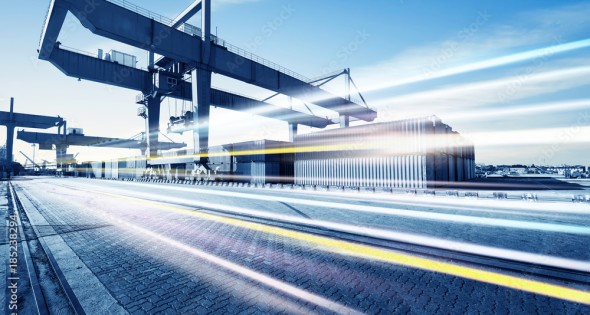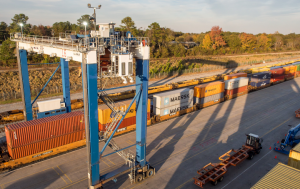
Intermodal Operations are Addressing Congestion, Holdups, and New Ways of Managing Freight
01 May, 2022
Getting freight to its destination has been a major issue across the globe during the pandemic – but new ideas are gaining traction
Distribution managers are taking a closer look at the value that intermodal delivery brings to their operations.
Intermodal distribution, compared to a single road system (haulage), represents a 20 percent savings in transport costs, according to recent study “Intermodal transport in freight distribution: a literature review.”
Research has also shown that there is a growing importance due to the role of intermodal transport in reduced environmental impacts on transport. It has been discovered that an intermodal system can minimize environmental impact by as much as 57 percent in terms of CO2 emissions compared to a unimodal system.
Newer research has addressed other topics with great future potential, according to the study, such as the development of new policies and network design.
There is also a desire to arrive at a more precisely defined term for intermodal than simply “the technical exercise of transporting goods by two or more modes of transportation using a loading unit.”
The terms multimodal, co-modal and synchromodal transportation are all used to refer to multimodal transportation. Industry developers are looking at proposals for the construction of a suitable administrative and legal framework to mark the boundaries of intermodality.
Research has also found that the analysis of determining factors, such as the advantages associated with the use of each of the modes, the congestion of the road transportation system, transportation costs and environmental impact with frequent greenhouse gas emission, among other things, offers competitive intermodal solutions that are framed in road-rail, air–road, sea–rail and sea–road mode systems.
But infrastructure availability and vehicle capacity are variables that may restrict the use of a specific mode, according to the study.
What is Changing in the Supply Chain?
Bill Thayer is the co-founder and CEO of Fillogic, working in retail and logistics. He came up with a unique idea of how to handle some of the freight handling lack of capacity that he sees in the supply chain for retail operations. “There are not enough warehouses, not enough trucks, and now not enough truck drivers and warehouse workers,” he said.
Since the start of the pandemic, eCommerce has just grown astronomically, he said, and even though it’s starting to level off a little bit, the change is still impacted heavily by just the lack of capacity.
So he found underutilized spaces in shopping malls. “We’re not taking portions of shopping malls, and knocking them down and putting up warehouses,” he said. “We’re taking existing infrastructure which is outside of the gross leasable area and converting them into micro-distribution centers. We’re big believers in that physical retail is not dead. It’s in transformation. And what it’s transforming to is mixed-use. Physical retail is a mixture of retail, experiential entertainment and food.”

One of two inland ports managed by the South Carolina Ports Authority. The port is developing an intermodal container transfer facility project that would allow near-dock rail adjacent to a new container terminal. Courtesy SCSPA
What he does see that is really unique is connectivity, or the data visibility platforms, and companies making better utilization of infrastructure. “You’re taking a business that was built on relationships for many years that is highly averse to technology, and then getting them to understand that it’s no longer about your truckload relationships,” Thayer said. “It’s now about the technologies that can improve visibility. That’s tough for a lot of supply chain folks to get their heads around.”
The supply chain disruption issues are going to get fixed by technology and innovation by the private sector, Thayer said, and not by getting legislated. “Big trucking companies aren’t going to wake up and say, ‘Hey, this is what we’re going do.’”
Intermodal distribution as supply chain are all about reducing touches, he said. “It takes five touches to move something. So how do you get to three? How do you get it to two?,” he said. “There’s just lots of things that we don’t have to be figured out.”
Better Planning and Collaboration
The study noted that attention needs to be paid to planning and linkage processes, the abilities of meeting the requirements for the service to be delivered, the importance of systems and communication technologies, and the personnel with enough basic skills to keep the system running efficiently. “Collaboration, integration and linkages among the transport network actors is essential through technology and the flow of suitable information for undertaking planning that enables maximum benefit to be taken from system capacities, freight traffic to be increased, and its security to be impacted,” the study concluded.
The study found that optimizing intermodal systems mostly pivots around a relationship based on minimizing costs and time, and maximizing users’ profits. “Other variables are included in the process in order to find solutions that broaden and limit the objectivity spectrum of the results: numbers of vehicles and their capacity, intermodal terminals, distances between hubs and the speed with which they can be covered, freight transshipment times and keeping to scheduled activities and times.”
The Pandemic as a Change Agent
Intermodal distribution, like a lot of the elements of the supply chain, was and is still trying to manage the pandemic.
It has struggled operationally and has not yet recovered, according to Larry Gross, a freight transportation sector specialist and intermodal analyst. “When we talk about intermodal, one important concept to understand is that intermodal is really two different sectors. There’s the international piece, which is the movement of containers from the ports to inland locations. That’s about how half of all intermodal revenue moves. The other half is the 53 foot domestic containers and trailers, which are mostly domestic containers.
That is the more truck competitive piece.
“Those different sectors have different characteristics, and different drivers. The international side is going to be very heavily influenced by what’s happening with regards to imports. Where are the imports arriving? And are they moving inland or not?”
Domestic v. International Product Movement
Domestic product movement is affected more by competitive aspects with truck fuel prices, truck capacity and availability, Gross said. “It tends to be more dispersed in terms of its origins and destinations, and more surface sensitive, than the international side.”
Gross said that the international freight movement side is going through some exceptional difficulties in the last four months or so. “Just looking at the year to date through February, it’s down 16.5 percent,” he said. He cited a couple of reasons: One is the west to east coast shift in terms of where the imports are landing. “It’s shifting to the east coast to get away from some of the congestion that has plagued the west coast,” Gross said. “There’s also a potential labor situation come July, as the dockworkers contract is expiring.
“When stuff lands on the east coast, intermodal has a tougher time getting its piece of the pie because the lengths of haul off the east coast are shorter. So that is not an intermodal-favorable development.”
The International Side
Most of what happens on the international side of intermodal operations is that the ship’s containers are moved inland on trains that are bought from the railroad by the ocean carriers such as Maersk, Gross said. Having a rail line in or near the port helps them extend their services from the seaport to the inland point, he said, adding that they do that because the international containers have been in short supply due to congestion and longer cycle times. “You have many ports now have rail intermodal ramps literally on the dock,” Gross said. “So that it is as seamless as possible to get the containers off the ship and onto the train, without an intermediate trip over public highways and having to go through the gate.”
All of that freight movement is problematic right now due to congestion, Gross said. “There have been issues at the inland port locations, primarily revolving around shortages of the chassis, which are the skeletal trailers that transport the containers on the highway. Because the volumes have been high and the cycle times have been elongated, there haven’t been enough chassis to go around. And that causes backups at the end of location which has been problematic from an operational standpoint.”
Looking for solutions to operational problems
Those operational problems are tricky to work out, because new disruptions, some geopolitical in nature, cannot be predicted. “Oftentimes during this recovery, when things have been so volatile, decisions that made sense at the time turned out to be badly timed,” Gross said. “And when everybody is making the same ‘intelligent’ decision, it becomes not intelligent, because everybody’s trying to crowd through the same keyhole.”
The new supply chain = a supply web
One methodology that is being considered is where intermodal operators get a more diverse set of origins for shipments. “People are not really comfortable anymore (with freight) being sourced in China, or at least most aren’t,” Gross said. “Where that freight now originates from now is a broad array of locations, such as southeast Asia, India, eastern Europe, even Africa and South America, as well as Mexico,” he said. “So when we talk about a supply chain, I actually think that a better term is supply web. That’s where we are seeing is a lot of fragmentation.”
When will intermodal recover?
Gross said that he doesn’t think things are going to go back to where they were pre-pandemic in regards to intermodal distribution. “Not only are we seeing dispersal in origin, but we’re seeing dispersal in destination,” he said. “Because we now all have the ability to work from home. And that reduces the need to be downtown, reduces the need to be in a city altogether.”
Intermodal has become more of the focus of businesses across the country now, having emerged as the most economic way of delivering freight. But it’s under intense scrutiny today. “I think anytime that the supply chain is on the front page of The New York Times or The Washington Post above the fold, it’s not because we’re doing such a great job,” Gross said.










